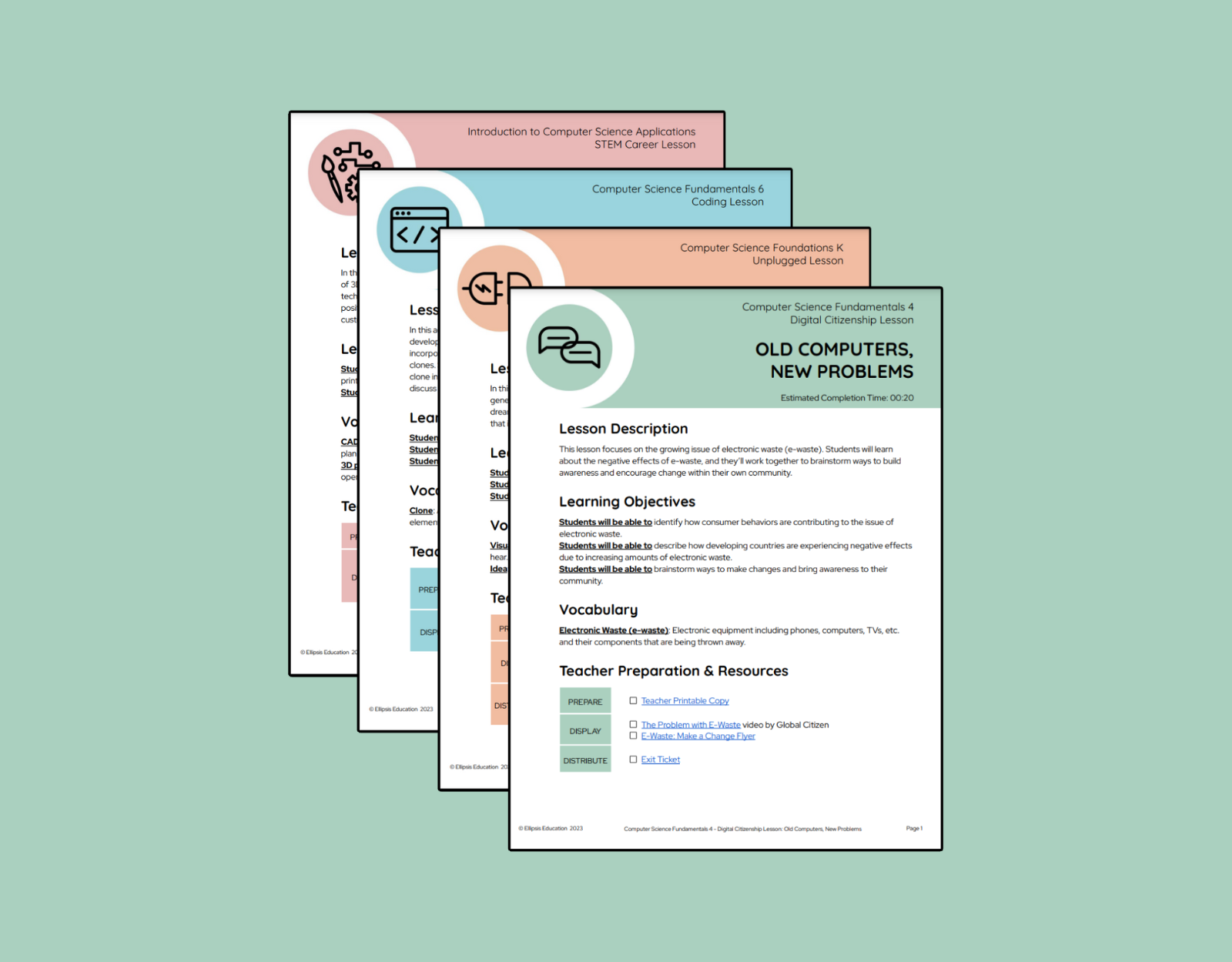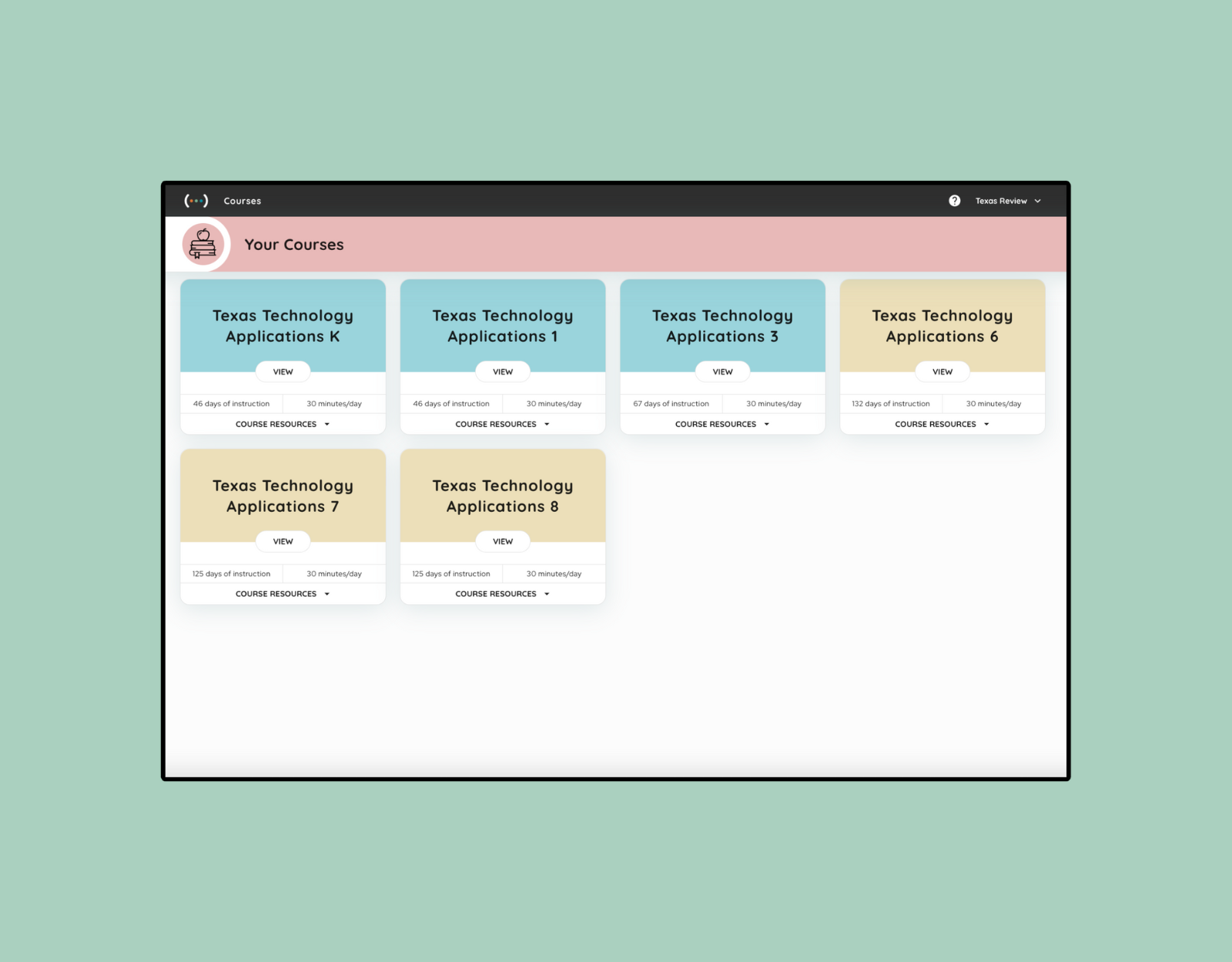TEKS Technology Standards
The Technology Applications TEKS are up for review this year as part of Proc 24! Ellipsis Education is in the running to become an Approved Instructional Material. We put learning in context so a teacher, not a machine, helps students connect the dots and apply technology skills in their lives.
Why Ellipsis Education?
There are many different programs that support the Technology Applications TEKS.
District partners choose to work with Ellipsis Education because they believe:
K-8 Tech Apps Curriculum
Our K-8 courses have everything you need to get students going: detailed lesson plans (beyond just coding), pacing guides, standards maps, and ongoing support.
Thoughtfully Designed for Texas Educators
With Ellipsis curriculum, teachers put learning in context so students can tie it all together.
Computer science, taught by teachers.
Comprehensive curriculum from Ellipsis Education (Coder Kids, Inc.) puts learning in context, so a teacher, not a machine, brings computer science to life. Explore curriculum for K-5 (state-adopted instructional material) and 6-8 (TEKS aligned).
TEKS Technology Standards
The TEKS technology standards, which stands for Texas Essential Knowledge and Skills, are a comprehensive set of guidelines established by the Texas Education Agency (TEA) to ensure that students across the state are equipped with the necessary knowledge in various subject areas, including computer science and technology. These standards play a critical role in shaping the curriculum for K-12 education in Texas and provide a framework for teachers to effectively integrate technology into their lesson plans. One key aspect of the TEKS technology standards is its focus on Texas Computer Science.
As our world becomes increasingly digitized, it is essential that students develop a strong foundation in computer science principles and practices. The TEKS standards address this need by outlining specific learning objectives related to:
- computational thinking
- coding
- data analysis
- cybersecurity
- and more
As a part of these guidelines, teachers are encouraged to incorporate hands-on activities and project-based learning experiences that allow students to apply their newfound skills in real-world situations. In addition to clarifying expectations for Texas Computer Science education, the TEKS technology standards encompass a broader range of topics under the umbrella term “technology TEKS.”
These guidelines touch upon various aspects of digital literacy – from basic computer operations and internet safety protocols to more advanced concepts such as multimedia production and information management systems. By providing explicit directives on these subjects, the TEKS ensure that all students receive adequate exposure to vital technological skills throughout their academic careers. An essential feature of Technology TEKS Texas is its emphasis on preparing students for 21st-century careers through the seamless integration of technologically driven content across all subject areas. The TEKS standards recognize that today’s workforce requires individuals who can effectively navigate digital tools while applying critical thinking skills to solve complex problems.
To support this goal, educators are urged to weave technology-centric lessons into their curricula – not only within dedicated computer science courses but also as supplements to traditional subjects like mathematics, science, social studies, and language arts. Moreover, the TEKS standards provide a detailed roadmap for educators to assess and continually refine their teaching strategies. By clearly delineating objectives within each content area, teachers can monitor student progress more effectively and adjust their lesson plans accordingly. This data-driven approach allows for targeted instruction that caters to students’ unique needs while ensuring they remain on track to achieve established benchmarks.
The TEKS technology standards serve as a critical foundation for Texas K-12 education by outlining specific learning objectives related to computer science and various aspects of digital literacy. These guidelines not only prepare students for success in an increasingly digital world but also empower educators with a clear framework for integrating technology into their classrooms. By adhering to these comprehensive standards, Texas schools are poised to foster generations of technologically-savvy individuals who are well-prepared for the challenges and opportunities of the 21st-century workforce.
Implementation Of TEKS Technology Standards
The implementation of TEKS Technology Standards is a critical aspect of the modern educational landscape, particularly in light of the increasing importance of technology and computer science in today’s world. These standards are designed to ensure that students gain a comprehensive understanding of technology-related subjects, preparing them for future academic and professional success. By incorporating these standards into the curriculum and lesson plans, educators can provide their students with the tools they need to succeed in an increasingly technological society.
One valuable resource for implementing these standards is the TEKS Guide, which provides educators with a detailed roadmap for incorporating technology education into their classrooms. The guide outlines the specific knowledge and skills that students should acquire at each grade level, offering clear benchmarks against which teachers can measure their progress. Additionally, the TEKS Guide offers suggestions for instructional strategies and assessment techniques that can help ensure student mastery of key concepts.
When it comes to implementing TEKS resource materials into classroom instruction, there are myriad options available to educators looking to make impactful choices. These include:
- textbooks
- digital resources
- hands-on activities
- real-world experiences
Teachers have access to a wide variety of materials that can support their efforts to integrate technology education into daily lessons. By carefully selecting resources aligned with student needs and instructional goals, educators can ensure that their students receive a well-rounded introduction to essential technological concepts. The process of implementing TEKS varies depending on specific subject matter but generally involves teachers closely examining their current curricula and identifying opportunities for improvement or enhancement by using appropriate resources aligned with the standards. This may involve revisiting lesson plans or rewriting existing units while keeping desired learning outcomes under consideration. In some cases, this may necessitate rethinking entire courses or designing new ones from scratch.
The successful implementation of TEKS Technology Standards requires not only the selection of high-quality resources but also attention paid on how such resources are integrated into teaching practices while ensuring alignment with state requirements. Teachers must be diligent in monitoring student progress and using data-driven decision-making to adjust instruction as needed. This may involve adjusting instructional strategies, differentiating lessons, or providing additional support to struggling students.
Developing a Technology TEKS curriculum requires careful planning and collaboration among educators. By working together to establish clear learning goals and select appropriate resources, teachers can create a coherent and engaging course of study that addresses the diverse needs of their students. Additionally, by integrating technology education across multiple subject areas, educators can help students make connections between disciplines and gain a more comprehensive understanding of the role that technology plays in their lives.
Creating a computer science curriculum” aligned with TEKS standards involves addressing essential computational thinking skills such as:
- problem-solving
- algorithm development
- data representation
- abstraction
Teachers should also ensure that their curricula cover important topics such as programming languages, cybersecurity principles, artificial intelligence applications, and the ethical use of technology. In doing so, they will prepare their students for future success in an increasingly digital world.
Finally, developing TEKS lesson plans involves not only selecting appropriate resources but also considering instructional strategies that engage learners actively while promoting critical thinking skills. Teachers must be thoughtful about the methods they employ to introduce new concepts or reinforce previously taught material while providing opportunities for hands-on exploration whenever possible. By doing so, they will create effective learning experiences that enable students to grow both academically and personally within a technology-rich environment.
Benefits And Considerations Of TEKS Technology Standards
The benefits and considerations of TEKS Technology Standards have become increasingly prominent in the modern educational landscape. These standards, which encompass computer science standards, are designed to provide students with the necessary skills and knowledge required for successful participation in an ever-evolving digital society. As more and more schools implement these standards into their curricula, the need for understanding their advantages and potential drawbacks has become essential for educators, administrators, and parents alike.
One of the most significant benefits of TEKS technology standards is that they provide a clear framework for digital literacy. By incorporating computer science principles into everyday instruction, students gain exposure to essential concepts such as coding, data analysis, and algorithmic thinking. This early exposure can help ignite an interest in pursuing careers within the technology sector, which continues to grow at an exponential rate. Furthermore, TEKS resource guides aid educators in aligning their lesson plans with these critical digital competencies.
Another advantage of implementing technology TEKS standards is that they promote collaboration between teachers across various disciplines. These guidelines encompass a wide range of subjects, such as:
* mathematics
* English language arts
* science
* social studies
* fine arts
* and others
Teachers are encouraged to work together in developing cross-curricular connections that emphasize digital skills. This interdisciplinary approach not only enriches learning opportunities but also fosters a sense of community among faculty members. Of course, the implementation of TEKS computer science standards is not without its challenges. For many educators who may be unfamiliar with certain technological concepts or practices themselves, adopting these guidelines can be intimidating and even overwhelming. Thus it becomes crucial for schools to invest in professional development opportunities that support teachers as they navigate this new terrain.
In addition to training educators on how best to incorporate these new skill sets into their classrooms effectively, there is also the matter of ensuring that all students have equal access to appropriate hardware and software needed to meet these benchmarks fully. The so-called “digital divide” persists globally – more affluence in certain communities guarantees a higher level of access to technology. As such, it is vital that efforts are made to address this discrepancy so that all students can benefit from the advantages offered by these guidelines.
There is an ongoing debate among computer science teachers regarding the depth and scope of TEKS technology standards. Some argue that the current framework may be too broad or elementary for advanced students who require a more comprehensive understanding of computer science principles. Conversely, others contend that these standards are appropriate given their primary purpose – which is to furnish all students with a foundational grasp of digital skills.
Ultimately, while there are undoubtedly challenges associated with adopting TEKS technology standards, the potential benefits for both students and teachers are immense. By providing clear guidelines for digital literacy, fostering collaboration among educators across various disciplines, and addressing potential disparities in access to technology resources, these benchmarks have the potential to create well-rounded learners who are poised for success in an increasingly interconnected world.
With continued investment in professional development opportunities for instructors and an ongoing dialogue surrounding best practices within the field of computer science education, TEKS technology standards can serve as valuable tools within today’s educational landscape.
Related Links
Ready to Learn More?
See how Technology Applications Curriculum from Ellipsis Education can work in your district. Request a meeting with our accounts team to share your goals and explore our Tech Apps curriculum. If interested, you can also explore our computer science offering for grades 6-8.






